Roasted Sunchokes
Roasted Sunchokes are sliced and tossed with olive oil, salt, pepper, and roasted until caramelized and tender. An EASY and healthy vegetable side dish for fall or winter!
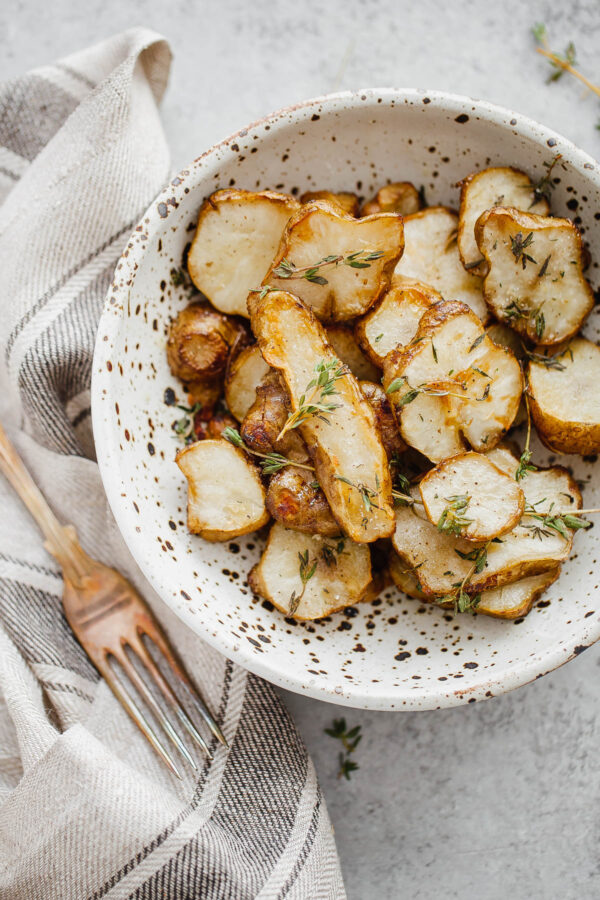
Roasted Sunchokes
My first experience tasting a sunchoke was a very memorable one. I was visiting my parents in Scotland about seven years ago and we went out to an amazing restaurant where my mom and I enjoyed sunchoke soup with pancetta and fresh black truffles. It was literally one of the best soups that I’ve ever had in my life.
My second experience with sunchokes came several years later when I was working as a line cook in Washington, DC. At our restaurant, we used to slice sunchokes with a mandolin until they were paper thin and throw them in the fryer to produce light-as-air sunchoke chips. So addictive!
Since I happened to get my hands on a bag of sunchokes last week and we’re currently in the thick of sunchoke season (late fall to early spring), I thought it would be fun to dive deeper into this somewhat obscure root vegetable and share this simple roasted sunchokes recipe with you.
If you’ve never prepared sunchokes (or have always wondered how to prepare or cook sunchokes), this recipe and back-to-basics post is for you.
Back to Basics: Sunchokes
Part of the confusion and mystery of sunchokes relates to their name. They’re often referred to as Jerusalem artichokes; however they are not from Jerusalem, nor are they part of the artichoke family. Sunchokes are actually the tuberous roots of a sunflower plant. Weird, right?
They come in various sizes, shades of color, and are knobbly like fresh ginger root. In fact, they can easily be mistaken for small pieces of ginger at first glance. Sunchokes are often prepared similarly to potatoes, but have a crunchy texture when raw (yes, you can eat them raw!) that reminds me of a radish or turnip.
Nutritionally speaking, sunchokes are incredibly good for you. They are very high in iron, potassium, and indigestible fiber (prebiotics, specifically inulin) and are a wonderful low-carb (and lower calorie) alternative to potatoes or other higher-carb root vegetables.
How to Select and Store Sunchokes:
Sunchokes come in various shades of colors ranging from light brown (as shown above) to a slightly reddish or purple-y hue. Look for firm sunchokes without any soft spots. Large sunchokes with minimal knobs are more ideal for roasting and generally easier to work with, as you’ll be able to keep the slices more uniform.
Sunchokes should be placed in a plastic bag or cloth in your refrigerator vegetable drawer, and can be stored for up to two weeks.
How to Cook Sunchokes:
Sunchokes can be served raw, roasted, fried, pureed into soups, or steamed. Similarly to celery root, sunchokes will oxidize when sliced, so it’s best to use them right away or store them in acidulated water (water with the juice of one lemon) if not using immediately.
When roasting sunchokes, I leave the skin on as it makes them very easy to prepare. If you’re serving sunchokes raw, I recommend peeling them. Try to find large sunchokes with minimal to no knobs, as they are nearly impossible to peel otherwise!
For roasting, simply slice sunchokes into 1/2-inch thick slices, toss with olive oil, salt, and pepper, and roast at 425 degrees for about 20 minutes. You can also slow roast them at 325 to 350 degrees. Toss the roasted sunchokes with fresh herbs, such as thyme or rosemary, just before serving or keep them simple.
Important Dietary Note: Sunchokes are a high source of inulin, which can cause stomach discomfort for some people, especially if eaten in large quantities. If you’re unsure, I recommend removing most of the peel prior to roasting and reducing serving size.
Sunchokes have a wonderful and intensely nutty and sweet flavor. Once cooked or roasted, their texture resembles that of a creamy potato (similar to these roasted fingerling potatoes).
They’re delicious and worth seeking out, especially during the fall and winter months!
Other Ways to Prepare Sunchokes:
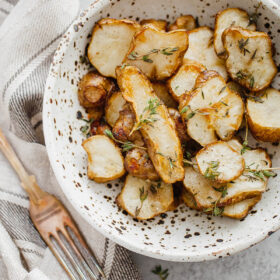
Roasted Sunchokes
Ingredients
- 1 lb sunchokes (Jerusalem artichokes) *see recipe notes rinsed and scrubbed well, and cut into ½-inch thick slices
- 1½ tablespoons extra virgin olive oil plus more for drizzling
- ½ teaspoon kosher salt
- freshly ground black pepper
- 1-2 sprigs fresh thyme finely chopped
Instructions
- Note: Sunchokes are a high source of inulin, which can cause stomach discomfort for some people, especially if eaten in large quantities. If you're unsure, I recommend removing most of the peel prior to roasting.
- Preheat the oven to 425° Fahrenheit (220°C) with a rack in the center position. In a medium bowl, toss the sunchokes slices with the olive oil, salt, and pepper until well coated. Distribute the sunchokes, cut-side down in an even, thin layer on a half sheet pan. Be sure to leave space between them, as this will help them caramelize evenly.
- Roast for 18 to 22 minutes, flipping the pieces halfway through, or until the sunchokes are lightly caramelized and fork tender.
- Gently toss the roasted sunchokes with freshly chopped thyme leaves and a light sprinkle of kosher salt. I like to drizzle them lightly with extra virgin olive oil before serving, but this is optional. Serve immediately.
Tips For Success:
- Sunchokes come in various shades of colors ranging from light brown (as shown above) to a slightly reddish hue. Look for firm sunchokes without any soft spots. Large sunchokes are more ideal for roasting as you'll be able to keep the sizes of the slices more uniform.
- Sunchokes should be stored in a plastic bag in the vegetable drawer of your refrigerator and can keep for about 2 weeks.

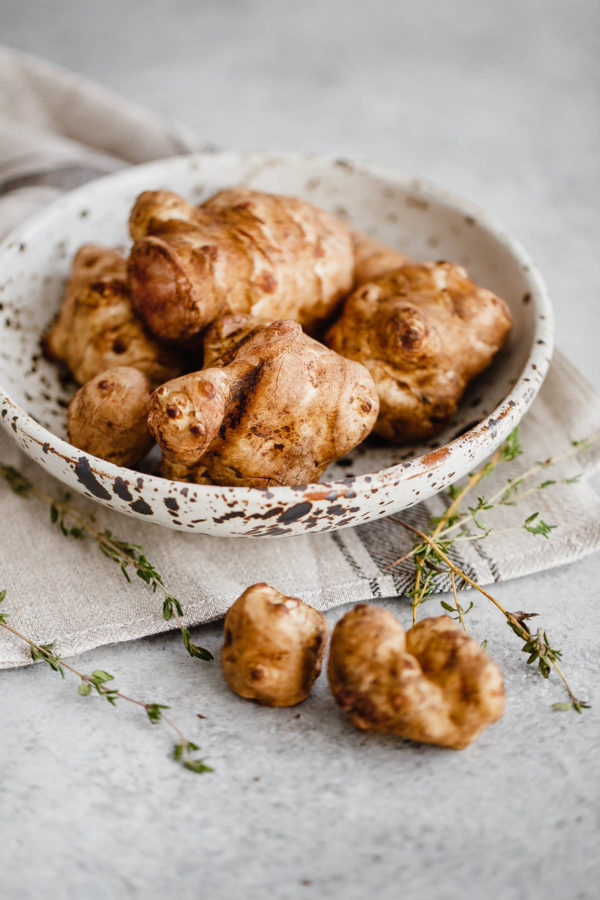
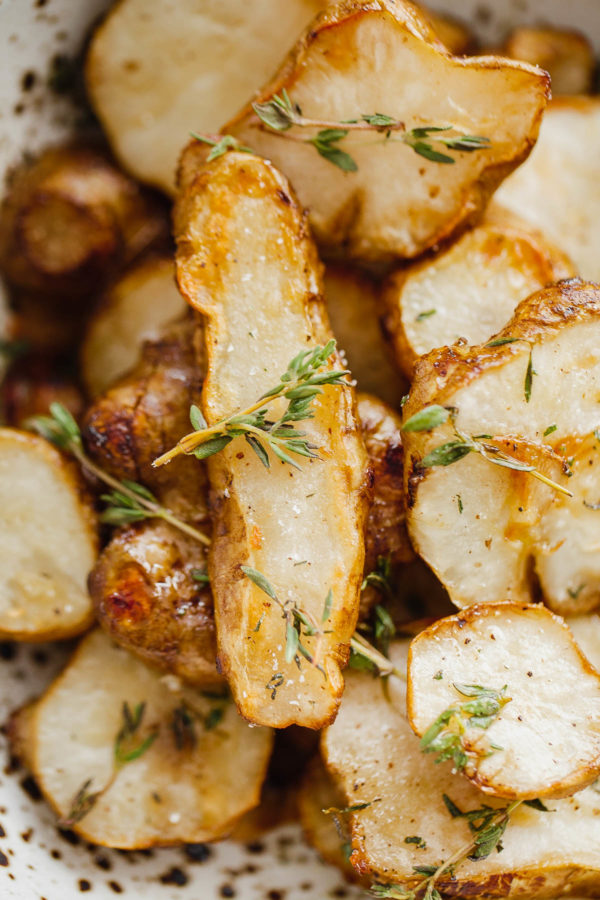
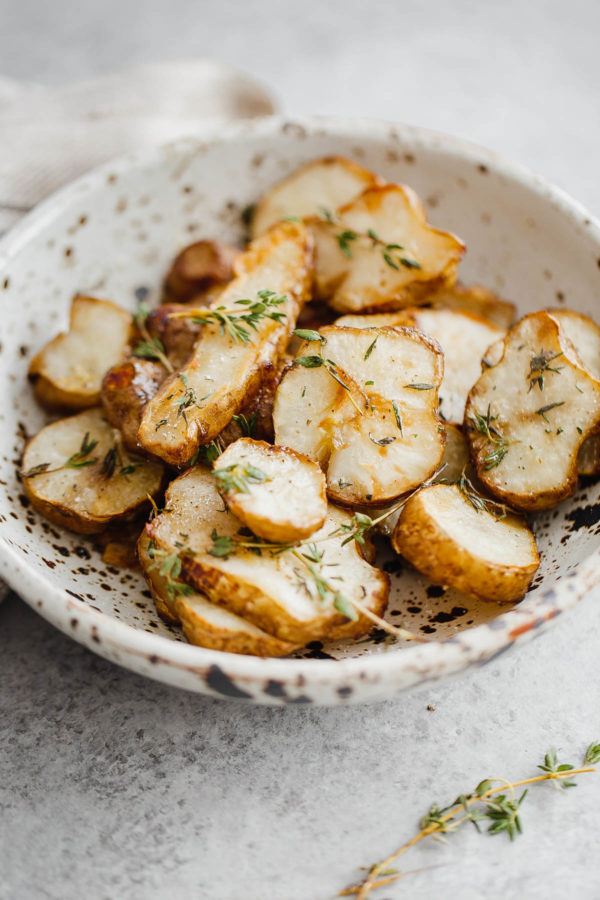
29 Comments on “Roasted Sunchokes”
I had sun choke and another vegetable (seems like anise) soup from Wholefoods. It was so good I looked for the recipe on the internet, made it, and had no stomach problems. I did peel it.I wonder if you soak them in water with a teaspoon of baking soda for a while would it eliminate the gas? That is what my sister does with beans to prevent having gas.
Also, I found the recipe and it is sunchoke and leek soup.
I ate roasted sunchokes for the first time, yesterday at 2:00 in the afternoon, at a restaurant. They were delicious! I came home and farted continuous high-powered blasts of air until past midnight. Thankfully they weren’t the stinky kind. Supposedly, if you slice and then soak them in water a couple times (like you would with dried beans) it’ll take most of the winds-producing properties out. Evidently the chef didn’t know that. Only because it wasn’t painful (and acrid) am I willing to give’em another try.
I’m growing a small quantity of sunchokes in a growbag in my yard and considering growing them as a perennial. I wanted to give them at try at the grocery store first to see if this is a vegetable I want to dedicate garden space to. I found them to be a cross between a potato and a water chestnut. My tubers were on the smaller side so some of the larger pieces were slightly undercooked and the smaller pieces over cooked. My kids couldn’t really tell the difference between these and potatoes except for the larger crunchier pieces. The recipe itself was simple and delicious. I’m hoping that the ones I grow will be more uniform size so I can get even cooking. No stomach upset for us. I’ve heard that peeling them can help with this for sensitive individuals. I can’t believe the comment above where someone blames their sensitivity on the recipe itself. How silly.
I liked them and my husband loved them. It was really easy to prepare, which is good because we have another 2 batches from our CSA!
What an AWFUL recipe!
Never been so sick!!!!
Sunchokes should only make you sick if you eat an enormous quantity of them – people buy and use sunchokes all the time in cooking. I added MULTIPLE disclaimers on the recipe that certain people can be sensitive to large quantities of the fiber they contain. I’m not sure how your rating is relevant to the actual recipe. This is like putting a 1 star rating on a bread recipe if you’re sensitive to gluten.
We received sunchokes in our farm subscription box and had never heard of them before. This recipe worked perfectly and now w look forward to enjoying more ways of enjoying this healthy veggie!
Absolutely delicious but as others have mentioned you may experience some stomach discomfort and terrible gas like I did.
Those of you who buy your sunchokes and have had gas problems, here is a likely solution. First you have to grow your own. Second, you need to live somewhere that has a cold winter(snow and frozen ground) Leaving the tubers in the ground during the winter helps season them and change the sugars such that they are way more digestible. The flavor is better too. I ate some in October and they caused all the above problems. Ate them in March and no gas at all.
March 13, 2022
Hi, I’m wondering if these
can be made in a convection oven?
Thank you.
Yes, of course! I would reduce temp by 25F and watch the time carefully because it might still have to be reduced a touch.
Oh my goodness! I’m laughing out loud at these comments! (Not at your pain, of course) And I’m a little scared to try them, but they look delicious!
Yummy Recipe! One nitpick…The tuber is actually not from a sunflower plant. It’s flower looks like a cross between a sunflower and a daisy, very pretty. Now for the twist! The sunflower and artichoke plants are very closely related. Looking up the artichoke flower always gives me kick. Thanks for the recipe, 5 stars. Cheers!
Should have read more about sunchokes aka FARTichokes. They were super tasty and really easy to prepare with help of this recipe (hence the 5 star rating). However, the aftermath of 12+ hours of flatulence and stomach cramps will keep me from eating these roots ever again.
Sunchokes! So tasty, yet so digestively unpleasant in quantity (at least for me). Word to the wise: if you already think you might be sensitive to inulin, don’t eat more than one sunchoke on your first try. Maybe see if you can build up slowly. Don’t eat a whole bunch just because they are delicious and “it probably won’t be a big deal.” It will be. You won’t enjoy it. Consider yourself forewarned.
A tad of truffle oil is an excellent finish
didnt get crunchy 🙁
They’re not supposed to be crunchy, they’re supposed to be similar to something like a roast potato.
I made these the other day they tasted amazing, some notes on the entire experience.
– peel them the skins are trash
– prepare for incredible gas these things destroyed my insides for hours and i never had such bad gas
How long do you keep them in the oven if you opt for slow roasting?
I’m not sure what temperature you’d be using, so I’d need more details to be specific, but maybe 45 minutes to 1 hour?
Great post! But sunchokes are DEFINITELY in the same family as artichokes (they are both in the Asteraceae family).
https://en.wikipedia.org/wiki/Jerusalem_artichoke
Angela, thank you for posting the link. It’s unfortunate that wikipedia refers to it as Jerusalem artichoke, thereby perpetuating the idea that it is related somehow to artichokes. They do clarify that it is in the sunflower family later in the article.
My grandmother use to make this dish! I love it! How come I didn’t think about it until now. Thanks!
I love everything about this post Laura- especially that you’re highlighting such an under-utilized but great winter storing veggie! Beautiful pics and lovely (and simple) recipe! Brava! 🙂
I’ve never worked with sunchokes, but they look amazing! Also, the version of throwing them int he frying sounds SO GOOD.
I was this close to sharing a fried sunchoke chip recipe and decided it might be a bit more than most people want to do! Haha. You can also make baked chips too but you’d have to be more careful with time/temp. Thanks Abby!! ?
I still have some leftover from my produce box! Totally going to make these! Love this post! <3